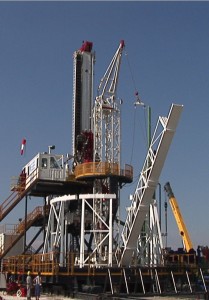Unconventional rig design improves performance by over 50% on horizontal wells
By Katie Mazerov, contributing editor
Unconventional, advanced-technology land rigs are not only smaller in size but also offer high mobility, reduced cost, enhanced safety and a reduced environmental footprint, said Marco Cercato, business development manager for Drillmec Drilling Technologies. He compared conventional and unconventional rigs in a presentation at the 2011 IADC Advanced Rig Technology Conference & Exhibition last month in Houston.

The company’s Hydraulic Hoist (HH) rig series was among the first advanced-technology rig designs in the market, he said. “The design starts with a complete hydraulic system based on a telescopic mast made with just one telescopic cylinder. The goal was to go from a crowded rig floor to a clean rig floor, where about 80% of the routine activity can be done totally unmanned.”
Comparing the characteristics of an HH 1,200-hp rig with a standard 1,500-hp rig, Mr Cercato said the advantages include the newer rig’s compact size (101 ft high versus 165 ft), telescopic mast, integrated hydraulic top drive, automatic pipe handler, motorized rotary table and vertical pipe rack system. The trailer-transported rig is elevated with its own piston to the required height of the rig floor and the BOP stack.
Drilling time can be cut by half to 12 days, according to Mr Cercato. “This design offers a 50% reduction in the number of loads, nine versus 18,” he said. “Depending on the model, rig-up and rig-down time can be completed in a matter of hours. The automated system allows the driller to preset parameters, especially weight and bit in a constant way, resulting in better performance in difficult wells.”
The integrated top drive can move back and forth from the center hole to the mousehole. No one is above the rig floor, and there are no drawworks or line around the rig. The automatic pipe handler, which is installed on some HH rigs, works independently, taking pipe from the vertical pipe rack and placing them into the mousehole.
The casing-running tool takes casing joints to the rig via elevators and through a space between two of the pipe containers. The tool can rotate, reciprocate and circulate during casing running.
Reduced personnel
The rig also reduces the number of required personnel to four – one driller, two assistants and a rotary helper. “The driller is there to check everything on the rig, from the mud tank to the pump,” Mr Cercato said. “He can intervene at any time and change certain positions. The most common intervention is to adjust the height of the power tong depending on the height of the tooljoints.”
According to Mr Cercato, the HH rig has been shown to offer an average 30% increase in drilling performance; an average 30% reduction in cost and NPT; up to 50% reduction in location dimension and a 40% average reduction in moving and rig-up/rig-down costs.
Additionally, a five-year study showed that the rig improved drilling performance by 30% on vertical wells, almost 50% on high-angle, directional wells and more than 50% on horizontal wells, Mr Cercato continued. Automatic tripping time averaged 30 joints/hr, or 500 to 600 meters/hr.
HH rigs have been deployed worldwide. The series ranges from small rigs with no automatic pipe handling for less complex wells to more automated designs for workovers.




